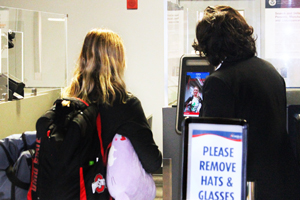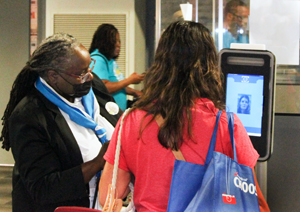BALTIMORE – U.S. Customs and Border Protection (CBP), in partnership with Carnival Cruise Line, expanded the use of facial biometrics into the debarkation process at the Port of Baltimore, becoming the latest seaport to modernize efforts to revolutionize cruise travel.
“As cruise travel resumes around our nation’s ports, CBP is excited to partner with Carnival Cruise Line and the Maryland Port Administration to deliver a safe and secure identity verification process for cruise travelers at the Port of Baltimore cruise terminal,” said Stephen Maloney, CBP’s Director of Field Operations for the Baltimore Field Office. “CBP’s public-private partnerships to expand biometric facial comparison at our air, land and seaports of entry has been critical to enhancing our nation’s security, streamlining travel efficiency and improving customer experience, while protecting the privacy of all travelers.”
This innovative entry process further secures and enhances the customer experience while protecting the privacy of all travelers. The enhanced arrival process using facial biometrics verifies the traveler’s identity within two seconds and is more than 98% accurate. When debarking the cruise vessel at a U.S. seaport, passengers will pause for a photo that will be compared to the traveler’s existing passport or visa photo in secure DHS systems to biometrically verify their identity.
U.S. travelers and select foreign nationals who are not required to provide biometrics and wish to opt out of the new biometric process can simply request a manual document check from a CBP Officer consistent with existing requirements for admission into the United States.
To date, facial biometric comparison technology is available at 14 seaports across the United States and has been successfully used to process arriving passengers on cruise vessels in Florida, New Jersey, New York, Texas, California, Washington, Louisiana, Alabama, Puerto Rico, and now Maryland.
Currently, more than 187 million travelers have participated in the biometric facial comparison process at air, land, and seaports of entry.
As of June 2022, CBP has leveraged facial biometrics to prevent more than 1,500 impostors using genuine travel documents from illegally entering the United States at air and land Ports of Entry. More information on CBP’s use of biometric facial comparison technology to secure and streamline the arrival and departure process can be found here.
The Baltimore Field Office covers ports of entry throughout the states of Maryland, Virginia, Pennsylvania, Delaware, and West Virginia.
CBP's border security mission is led at ports of entry by CBP officers and agriculture specialists from the Office of Field Operations. CBP screens international travelers and cargo and searches for illicit narcotics, unreported currency, weapons, counterfeit consumer goods, prohibited agriculture, invasive weeds and pests, and other illicit products that could potentially harm the American public, U.S. businesses, and our nation’s safety and economic vitality. Learn what CBP accomplished during "A Typical Day" in 2021. Learn more about CBP at www.CBP.gov.
Follow the Director of CBP’s Baltimore Field Office on Twitter at @DFOBaltimore for breaking news, current events, human interest stories and photos, and CBP’s Office of Field Operations on Instagram at @cbpfieldops.




